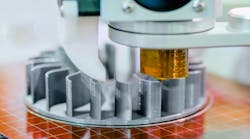Where Manufacturing Technology Goes in 2023: Part 3, Additive Manufacturing
Adding to Additive’s Portfolio
Additive manufacturing (AM) has grown beyond its traditional rapid prototyping confines. While still employed widely for that purpose, additive also creates custom products for customers and new tooling for plant operators. The list of available materials expanded in 2022, opening up new avenues to exploit the technology. So what can we expect on the additive front next year?
“In industrial markets, there has been a tremendous uptick in the number of manufacturers that are embracing metal AM for the production of end-use parts, particularly in the aerospace and energy markets. I believe we’ll see that activity continue and that it will be bolstered by composite materials gaining traction for production applications. This will be facilitated by the evolution of the materials as well as the 3D printing technology,” says Dr. Jeffrey Graves, president & CEO, 3D Systems.
“In the year ahead, I anticipate new AM solutions that are designed specifically for mass production whereby manufacturers will be able to rely on the technology to accelerate their workflows in ways not previously possible. This will be further enabled by end-to-end software solutions that combine a variety of printing and finishing technologies to not only enhance productivity but also maintain the traceability required by highly regulated environments,” Graves says.
“We continue to see an influx of companies moving to ‘just in time’ or ‘made to order’ parts designs that can be housed digitally to reduce physical inventory cost and remove the concern around where the physical inventory sits,” says Brent Noonan, president of the Americas at Stratasys. “We believe the trend of digital inventory will continue in 2023 with parts being made more easily in multiple locations, eliminating transportation bottlenecks, shortening lead times, and reducing carbon emissions from transportation.”
“As I look ahead to 2023… I believe we’ll see an increase in production-grade solutions targeting specific applications. An increasing number of materials are needed that meet custom, application-specific needs in different industries, including quality and regulatory standards,” says Reji Puthenveetil, executive vice president of Industrial Solutions at 3D Systems.
“These materials must deliver parts with the look, feel, accuracy, precision, mechanical characteristics, quality, and performance of end-use components. Customers no longer require production-like solutions. They need production solutions that can replace traditional manufacturing methods,” Puthenveetil says.
“As industries with high-mix production environments such as service bureaus, healthcare, and consumer goods strive to reduce the time and cost associated with preparing files for the printing process, I foresee AM software playing a key role in facilitating automation. This is possible due to the use of modern AI techniques such as deep learning that can uniquely drive very high levels of automation not previously possible,” says Ben Schrauwen, senior vice president and general manager at Oqton.
"As I look across the AM industry, I see a shift from AM being used mostly for low-volume production to a technology consistently demonstrating it is ready to deliver on high-volume, large-scale applications. This is becoming a reality not only in healthcare but also in consumer markets such as for toys, as well as for industrial applications such as electrical connectors," says Dr. Brent Stucker, chief technology officer at 3D Systems.
“We also expect a lot of advancements in the coming year in the software that helps our largest customers really scale up,” says Noonan. “Software has historically been mostly about setting up individual jobs on individual printers. That’s changing. Now we need to manage fleets of printers and many operators, perhaps over a wide geographic area—essentially digital virtual factories that can span the globe.”
“With the majority of businesses expecting supply chain issues to continue into 2023, there is a growing demand for sustainable, innovative manufacturing,” says Wayne Davey, global head of go-to-market, HP Personalization & 3D Printing, HP Inc.
“The near endless design and production opportunities with 3D printing will not only motivate manufacturers to prioritize sustainable innovation but will also unlock new and exciting applications across industries that will completely reshape the production floor and secure a healthier, more resilient global supply chain,” Davey says.
Where Manufacturing Technology Goes in 2023: Part 3, Additive Manufacturing was originally published on IndustryWeek, an Endeavor Business Media partner site.











